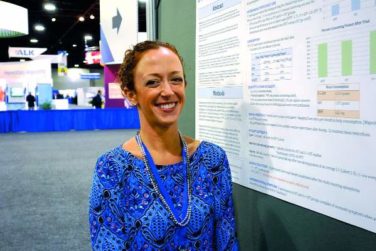FROM NEW ENGLAND JOURNAL OF MEDICINE
Patients with mantle cell lymphoma who received maintenance therapy with rituximab following autologous stem cell transplantation (ASCT) had significantly better overall survival, event-free survival, and progression-free survival, compared with patients who were followed with observation alone after transplant, results of a phase 3 trial show.
After 50.2 months median follow-up, the overall survival rate for patients aged 65 or younger randomized to rituximab maintenance after four cycles of induction chemotherapy with rituximab, dexamethasone, cytarabine, and a platinum derivative (R-DHAP) followed by ASCT was 89%, compared with 80% for patients randomized to observation (P = .004), reported Steven Le Gouill, MD, PhD, of University Hospital Hotel-Dieu, in Nantes, Frances, and colleagues.
In an unadjusted regression analysis, the difference translated into a hazard ratio for death within 4 years of 0.50 (P = .004) favoring rituximab, they wrote in the Sept. 28, 2017 issue of The New England Journal of Medicine .
“[A]n induction regimen with four courses of R-DHAP followed by transplantation without total-body irradiation resulted in a high rate of complete response. A 3-year course of rituximab maintenance therapy administered every 2 months prolonged overall survival among young patients with mantle cell lymphoma,” the investigators wrote (N Engl J Med. 2017;377:1250-60).
Dr. Le Gouill and his colleagues hypothesized that relapses following treatment for MCL may be caused by residual malignant cells that chemotherapy and ASCT fail to eradicate, suggesting that maintenance therapy with rituximab could help to suppress residual disease, prolong the duration of responses, and extend both progression-free and overall survival.
They cited an earlier study by members of the European Mantle Cell Lymphoma Network showing that among patients aged 60 and older who had a response to eight cycles of chemotherapy with rituximab, cyclophosphamide, doxorubicin, vincristine, and prednisone (R-CHOP), maintenance therapy with rituximab was associated with an 87% 4-year overall survival rate vs. 63% for patients maintained on interferon alfa (P = .005) (N Engl J Med. 2012;367:520-31).
For the current study, the researchers enrolled 299 patients, of whom 257 went on to ASCT, and 240 of whom were randomized and were included in an intention-to-treat (ITT) analysis.
Patients received induction with four cycles of R-DHAP. Those patients who had partial responses or tumor mass shrinkage of less than 75% on CT received a rescue induction with four cycles of R-CHOP.
Those patients with complete or partial responses could then go on to transplantation after a conditioning regimen of R-BEAM (rituximab, carmustine, etoposide, cytarabine, and melphalan).
Patients randomized after ASCT to rituximab received it every 2 months for 3 years in an intravenous infusion at a dose of 375 mg/m2.
After a median of 50.2 months from randomization, the rate of 4-year event-free survival (no disease progression, relapse, death, or severe infection), the primary endpoint, was 79% for patients maintained on rituximab vs. 61% for those on observation alone (P = .001).
The 4-year progression-free survival rate also favored rituximab at 83% vs. 64%, respectively (P less than .001), with respective overall survival rates of 89% and 80%.
The median event-free survival, progression-free survival, and overall survival was not reached in either study arm.
For the 59 patients who for various reasons did not undergo randomization, the median progression-free survival was 11.0 months, and the median overall survival was 30.6 months.
In all, 83 of the 120 patients randomized to rituximab completed the scheduled 3 years of therapy. Maintenance therapy was stopped for disease progression in 16 patients and because of neutropenia in 9. There were 13 deaths in the rituximab arm, including 3 deaths from second malignancies.
Of the 120 patients assigned to observation, 37 had disease progression during the study period, and 24 died, one from a second malignancy.
Four patients in each study arm had serious infections after ASCT, including one case each of spondylitis, pyelonephritis, septicemia, and varicella pneumonia in the rituximab group, and septicemia, cellulitis, meningitis, and severe pneumonia in the observation group.
Lymphoma was the cause of death in 8 patients assigned to rituximab, and in 16 assigned to observation.
The investigators noted that although some centers use total-body irradiation for conditioning prior to transplant, this modality is not available in all centers and is associated with both short- and long-term toxicities. The progression-free survival results seen in this trial, where only ablative drug regimens were used “suggest that total-body irradiation–based conditioning regimens may not be superior to chemotherapy alone when an effective regimen is used during induction,” they wrote.
The study was supported by Roche and Amgen. Dr. Le Gouill disclosed fees for consulting and honoraria from Roche, Janssen-Cilag, and Celgene. Multiple coauthors disclosed similar relationships with industry.





